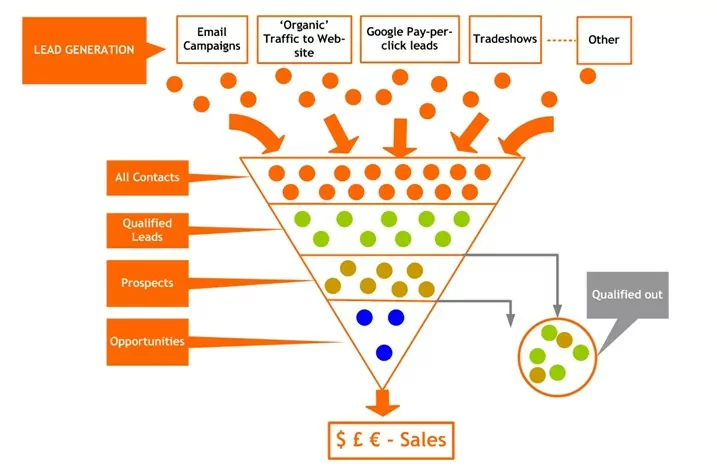In business, generating new leads is important since you need to attract people interested in your products and services. However, do you know what’s even more crucial to your long-term success? Knowing when and how to follow up with those leads ensures you close the sale. This is where sales lead tracking comes into play so your team can effectively drive conversions.
In this article, you’ll learn what sales lead tracking is and fully understand this process. Plus, you’ll discover how you can effortlessly track what your team does with leads.
Key Takeaways:
- Sales lead tracking allows you to see where each lead is within your sales funnel to better understand which actions to take to lead them toward making a purchase.
- This process is essential because you’ll know which leads have the most potential to buy. Therefore, you’ll know which ones to prioritize when following up to nurture relationships.
- Using a lead tracking tool and having regular meetings with your sales team can keep efforts organized and ensure everyone is on track to reach their targets.
What Is Sales Lead Tracking?
Through the process of sales lead tracking, you’re able to determine where each lead is in correspondence with your sales funnel. By knowing where they’re currently in the sales funnel, you’re better able to identify which action to take to lead them onto the next step.
Leads will require something different at each stage of the funnel. That means you must shape your content around their needs and conduct your outreach appropriately based on their location. The graphic below presents this in an easy-to-understand way as you attract leads, qualify or disqualify them, and ultimately get them to convert by making a purchase.
Source: VOIP Time Cloud
However, sales lead tracking isn’t just about knowing where a lead is within the sales funnel. Here are more benefits it can provide for your business:
- You Can Discover Where Leads Are Coming From: Knowing which sources are generating the most leads shows you what’s working and what’s not so you can direct your attention to your top-performing content formats and landing pages. Then, you can create more of what works.
- You’ll Distinguish Between Hot and Cold Leads: Your hottest leads have the highest likelihood of converting, so you can go the extra mile by reaching out to them when they’re in the decision-making stage. You can also identify which leads are going cold to re-engage them.
- You’re Able to Spend Time on the Right Leads: Time is money, and you don’t want to pour a ton of effort into a lead with no interest in converting. It’s better to weed out weaker leads so you can prioritize nurturing relationships with those more likely to buy from you.
If you fail to incorporate sales lead tracking into your business, it’ll be challenging to understand where leads are within your sales funnel. This means you won’t know which leads are potentially ready to buy, making it difficult for you to prioritize and nurture the right leads into a conversion.
How to Track What Your Sales Team Does With Leads
Once the leads start rolling in, it’s important to track what your sales team is doing from there. They can’t simply sit back and trust that people will move through the funnel independently. Sometimes action is required to encourage movement from one stage to the next. To ensure your team is staying on track and producing results, here are a few tips to implement:
1. Use a Lead Tracking Tool to Increase Efficiency
When it comes to sales lead tracking, there are a plethora of tools today that can assist with customer relationship management and project management. It would be worthwhile to test out some of the available tools to see what is best suited to your team. Consider the features you’d like a tool to have and what will fit within your company’s budget. The ideal tool will allow your team to manage all their leads in one place while prioritizing which ones they should focus on.
A tool like this will make it easy to see your team’s daily progress since their sales activities can be logged for you to review. For example, you can ensure each team member is pulling their weight. Plus, since each team member can have access, it’ll be easy to share data with everyone.
However, if you prefer to keep things simple, a spreadsheet can also be effective for tracking leads.
2. Measure Their Activity Based on Key Metrics
Sometimes we’re guilty of spending time on activities that don’t amount to much when producing the desired results. But because you want to ensure your team is as efficient as possible, it would be wise to track some key metrics to measure their daily activity on the job.
So, which metrics should you pay attention to? You may want to track something like the number of emails sent, as your sales team must be reaching out to prospective buyers. Keeping tabs on how many proposals are being sent, how many prospects they’re following up with, and how many calls they’re making can be equally as important. You’ll also need to review their lead response time so you know they’re replying in a timely fashion. And, of course, track how many deals they’re closing.
Now, many lead generation tasks can be automated. Research shows that 80% of marketers feel marketing automation helps generate more leads and conversions. However, there will always be tasks that need a human touch.
Image: Startup Bonsi
3. Have Regular Meetings to Discuss Progress
A typical day on the job probably has your team working independently for the most part. However, an important element of sales lead tracking is encouraging everyone to come together to discuss and review their progress. Make time to do this biweekly or monthly, at the very least.
Image: Salesforce
Regular meetings with your entire team allow you to share wins and new strategies to be implemented. Plus, you can address any issues that have come up so they can be resolved. This is also a great opportunity to review the latest data to see if your team is on track to hit their sales targets. If they’re not, you’ll know to take steps to improve their performance.
Get Your Team On Board With Sales Lead Tracking
Ready to empower your sales team to generate high-quality leads that will ultimately convert into paying customers? Here at MXTR, we can help. Our marketing strategies will ensure your company attracts the right leads and effortlessly reaches sales targets.
Contact us today to learn how our services can enhance your team’s success.










